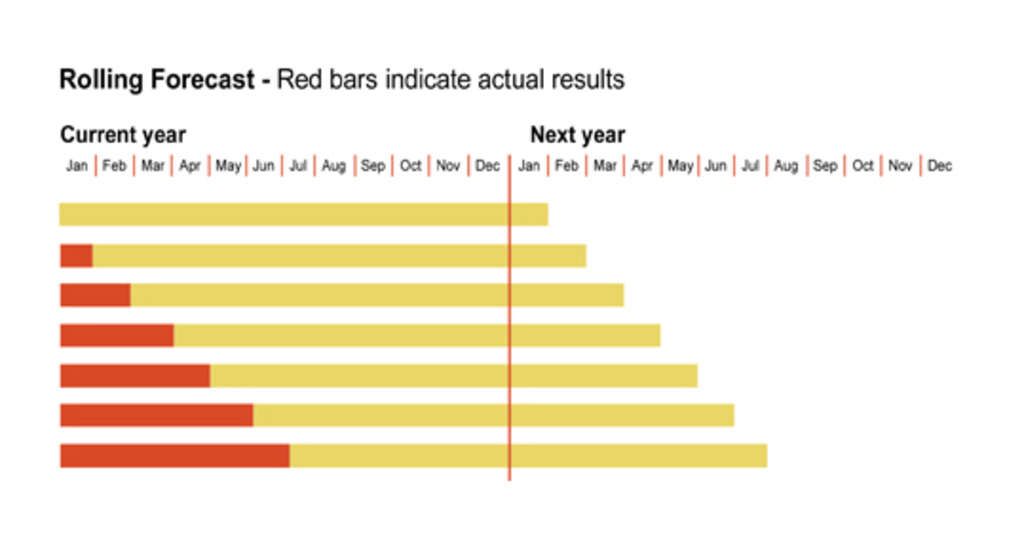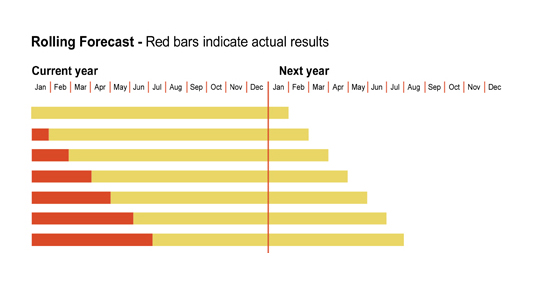Rolling Forecasts: How to manage future performance, not just predict it
Two key factors are shaping today's hotel performance – consumer technology and revenue management methodology. Increased use of technology has changed how consumers buy and hoteliers operate. With the adoption of revenue management, pricing is now established by market intelligence, not a hotel's margin requirements. To get some control back over profitability, operators should use the rolling forecast as a management tool.
One area to manage costs is resources. Hotels are forced to adjust resource usage based on daily fluctuations in occupancy and revenue. For example, over staffing one day cannot be easily made up for the next day due to inflexible staffing structures and minimum service thresholds.
A 2011 Expedia survey of hoteliers indicated a 28% increase in "same day bookings" with 65% of transactions on mobile devices being booked the same day as check-in. As changes occur faster, guests book later and hoteliers do not know what the average price is for the next day, week or even month. Traditional budgets or even monthly forecasts do not offer sufficient predictability or accuracy of business.
Another important metric is an accurate daily occupancy and revenue forecast. It is used to measure the accuracy of monthly income (e.g. actual month's bookings vs. forecast or budget). If the daily forecast is off, it does not represent the real difference as days with a negative deviation offset days with a positive variance. At the end of the month, the sum shows a deviation that is far better than what it actually is (see Table 1 – MAD stands for "Mean Absolute Deviation".)
Daily accuracy is crucial for both the right pricing strategy and optimal resource planning. In the example illustrated in Table 1, the following scenarios are possible: (1) a day where actual occupancy is higher than expected, one might be priced too low and take the chance of being under staffed, which means potential lost in upselling revenues, (2) a day where actual occupancy is lower than expected, a property might be priced too high, resulting in lower RevPAR and lower market penetration. And staffing is higher than demand. The right balance is obtained by comparing performance against the competition every day. Measuring deviations based on consolidated figures over a period does not show the truth lost revenue or resource waste as this does not balance out at the end of the period.
Motivation works best when the gap between reality and the target is close to zero, or even better if the target is just slightly ahead and is realistic enough that you can reach it. In this sense, a budget has a short shelf life. Shortly after completion, figures are out of date. So as an operational management tool, your budget is definitely out of date. Therefore, hoteliers need a management tool that is more effective and vibrant.
A new management model To answer the following three key questions – correctly and consistently, adjusting your management model could be worthwhile and of value to your business:
1. What are your department's performance targets for this month? 2. Where do you stand against those targets today? 3. What are your expected results for month's end?
How can your managers all three questions, when your booking manager and revenue manager determine the pricing in the various distribution channels daily? And your chef spends thousands of dollars on food every day? And your housekeeping lead determines how much extra help is called in each day? You can't answer these questions unless you use a rolling forecast model in your company.
Embracing the rolling forecasting A rolling forecasting is a formalized, standardized process for updating the forecast regularly. Estimates don't end, but project into the next forecast period. Forecasting periods usually range beyond the current fiscal year. Once a month is closed or is about to be closed, it is taken it out of the plan, and a new future month is added. That way the company will always have an updated forecast for fixed number of months into the future. A rolling forecast allows a company to respond quickly and manage resources according to changing economic needs.
More and more businesses are embracing rolling forecasting. Hotel companies, both small and large, are embracing the possibility of introducing a dynamic management model to get more out of their business.
Introducing a rolling forecast does not necessarily mean that one must abandon the annual budget. But what you do need to walk away from is a comprehensive annual budgeting process that overwhelms your operation. Spreadsheet revisions, negotiations, and the departmental politics take too much valuable management time. And worst of all, you get a product that does not reflect reality or have ownership across the enterprise.
Figure 1 illustrates the difference between the traditional planning cycle and the alternative of rolling forecasting and budgeting. Budgeting covers a fiscal year at a time and is prepared once a year, while a rolling forecasting is an ongoing process where the next 12 or more months are developed and continuously updated. This means you are moving from a deadline-driven reporting activity to an ongoing planning process.
Hotels operate in a highly uncertain market with many events affecting demand, occupancy and revenue patterns. To capture these changes and evaluate potential impacts, hotels need a model that is based on operational drivers (e.g., number of sold rooms, turnover, etc.) that are continuously updated so that decisions can be made and new initiatives implemented quickly and effectively.
A rolling forecast will not only provide superior and timely management information, but it is an important communication platform for the entire organization. Based on relevant facts, it ensures proper focus on the opportunities and challenges rather than spending time on predictions and interpretations. This type of tool enables hoteliers to control the elements that are controllable, so you reduce the risk of unforeseen financial consequences.
Executing the roll-out Branch managers must participate in the rolling forecasting process to create ownership and support the executions. A rolling forecasting is an ongoing process, in addition to reporting, which will strengthen the interaction and collaboration between managers, management and departments themselves. The easiest way is to start with a daily occupancy forecast that includes rate, RevPAR and lodging revenue. For those who do not have a revenue management system, this approach can be a good start to engage in revenue management systematically. Then the process can expand to cover Conference, F & B and other revenues.
Figure 2How often should a rolling forecast updated? Usage and revenue forecast should be updated daily. This applies especially for those engaged in systematic revenue management. As Figure 2 illustrates, focus on the next 30 days, based on current booking trends, and the corresponding period of the 13th month. Forecast the 13th month since you have yesterday's events in mind, and if the same events happen again next year. Ask what should be done differently to achieve a better result? This process is not only to predict future results, but importantly, it forces a manager to discuss and make important decisions that impact corporate profitability. Now the organization has a well thought out and thorough 13-month rolling forecast. It can be used to generate annual budgets, instead of spending several days or weeks to throw together a sales budget.
So what is your next step? It is possible to use a labor-intensive (and often error prone) manual spreadsheet-based system. But today's online solutions are more cost effective and far more flexible. Make sure you engage a system that connects all departments that use food and labor resources, such as housekeeping, conference & events, room service, kitchen, retail outlets, etc., and connects with your current systems such as your property management or revenue management systems. The clean flow of data between systems and into your rolling forecast will ensure accuracy and optimize profits.
About d2o
d2o is the leading provider of real-time performance management solutions for the hospitality industry. Its Performance Management Intelligence (PMI) Series is an integrated suite of dynamic performance navigation solutions that guide hotels and resorts to discover untapped profit by dynamically managing resources and preventing productivity loss. We empower operations to collaborate, share information and manage future outcomes. The result is the lowest possible F&B and labor costs and higher, predictable and sustainable profit. PMI solution functionality includes robust enterprise and department-level profit and loss budgeting and forecasting, as well as daily food cost control, employee scheduling and labor productivity management. Founded in Norway in 2000, d2o has offices in Europe and the United States serving its expanding global customer base of over 400 leading hotel chains, independents, and management companies. For more information, go to www.d2o.biz.
Katrina Pruitt-Andrews (for d2o)
KPA Marketing & PR
301.704.4087
d2o



